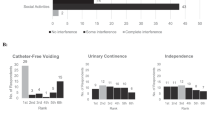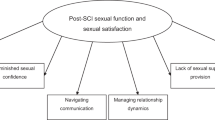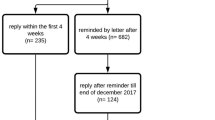Abstract
Study Design:
Secure, web-based survey.
Objectives:
Obtain information from the spinal cord injured (SCI) population regarding sexual dysfunctions, with the aim of developing new basic science and clinical research and eventual therapies targeting these issues.
Setting:
Worldwide web.
Methods:
Individuals 18 years or older living with SCI. Participants obtained a pass-code to enter a secure website and answered survey questions. A total of 286 subjects completed the survey.
Results:
The majority of participants stated that their SCI altered their sexual sense of self and that improving their sexual function would improve their quality of life (QoL). The primary reason for pursuing sexual activity was for intimacy need, not fertility. Bladder and bowel concerns during sexual activity were not strong enough to deter the majority of the population from engaging in sexual activity. However, in the subset of individuals concerned about bladder and/or bowel incontinence during sexual activity, this was a highly significant issue. In addition, the occurrence of autonomic dysreflexia (AD) during typical bladder or bowel care was a significant variable predicting the occurrence and distress of AD during sexual activity.
Conclusion:
Sexual function and its resultant impact on QoL is a major issue to an overwhelming majority of people living with SCI. This certainly constitutes the need for expanding research in multiple aspects to develop future therapeutic interventions for sexual health and SCI.
Sponsorship:
Christopher Reeve Foundation (#36708, KDA); Reeve-Irvine Research Center.
Similar content being viewed by others
Log in or create a free account to read this content
Gain free access to this article, as well as selected content from this journal and more on nature.com
or
References
Ackery A, Tator C, Krassioukov A . A global perspective on spinal cord injury epidemiology. J Neurotrauma 2004; 21: 1355–1370.
Stiens SA, Bergman SB, Formal CS . Spinal cord injury rehabilitation. 4. Individual experience, personal adaptation, and social perspectives. Arch Phys Med Rehabil 1997; 78: S65–S72.
Stiens SA, Kirshblum SC, Groah SL, McKinley WO, Gittler MS . Spinal cord injury medicine. 4. Optimal participation in life after spinal cord injury: physical, psychosocial, and economic reintegration into the environment. Arch Phys Med Rehabil 2002; 83: S72–S81.
Edgerton VE, Roy RR . Paralysis recovery in humans and model systems. Curr Opin Neurobiol 2002; 12: 658–667.
Batchelor PE, Howells DW . CNS regeneration: clinical possibility or basic science fantasy? J Clin Neurosci 2003; 10: 523–534.
Fouad K, Pearson K . Restoring walking after spinal cord injury. Prog Neurobiol 2004; 73: 107–126.
Ramer LM, Ramer MS, Steeves JD . Setting the stage for functional repair of spinal cord injuries: a cast of thousands. Spinal Cord 2005; 43: 134–161.
Anderson KD . Targeting recovery: priorities of the spinal cord injured population. J Neurotrauma 2004; 21: 1371–1383.
Burns AS, Rivas DA, Ditunno JD . The management of neurogenic bladder and sexual dysfunction after spinal cord injury. Spine 2001; 26: S129–S136.
Benevento BT, Sipski ML . Neurogenic bladder, neurogenic bowel, and sexual dysfunction in people with spinal cord injury. Phy Ther 2002; 82: 601–612.
DeForge D et al. Fertility following spinal cord injury: a systematic review. Spinal Cord 2005; 43: 693–703.
Kreuter M, Sullivan M, Siösteen A . Sexual adjustment and quality of relationships in spinal paraplegia: a controlled study. Arch Phys Med Rehabil 1996; 77: 541–548.
Kreuter M, Sullivan M, Dahllöf AG, Siösteen A . Partner relationships, functioning, mood and global quality of life in persons with spinal cord injury and traumatic brain injury. Spinal Cord 1998; 36: 252–261.
Ide M, Fugl-Meyer AR . Life satisfaction in persons with spinal cord injury: a comparative investigation between Sweden and Japan. Spinal Cord 2001; 39: 387–393.
Fisher TL, Laud PW, Byfield MG, Brown TT, Hayat MJ, Fiedler IG . Sexual health after spinal cord injury: a longitudinal study. Arch Phys Med Rehabil 2002; 83: 1043–1051.
Reitz A, Tobe V, Knapp PA, Schurch B . Impact of spinal cord injury on sexual health and quality of life. Int J Impot Res 2004; 16: 167–174.
Anderson KD, Borisoff JF, Johnson RD, Stiens SA, Elliott SL . Long-term effects of spinal cord injury on sexual function in men: Implications for neuroplasticity. Spinal Cord 2007; 45: 338–348 (this issue).
Anderson KD, Borisoff JF, Johnson RD, Stiens SA, Elliott SL . Spinal cord injury influences psychogenic as well as physical components of female sexual ability. Spinal Cord 2007; 45: 349–359 (this issue).
Stiens SA, Bergman SB, Goetz LL . Neurogenic bowel dysfunction after spinal cord injury: clinical evaluation and rehabilitative management. Arch Phys Med Rehabil 1997; 78: S86–S102.
National Spinal Cord Injury Statistical Center. Annual Report for the Model Spinal Cord Injury Care Systems. University of Alabama: Birmingham, AL 2005.
Edwards L, Krassioukov A, Fehlings M . Importance of access to research information among individuals with spinal cord injury: results of an evidence-based questionnaire. Spinal Cord 2002; 40: 529–535.
Phelps G et al. Sexual experience and plasma testosterone levels in male veterans after spinal cord injury. Arch Phys Med Rehabil 1983; 64: 47–52.
Charlifue SW, Gerhart KA, Menter RR, Whiteneck GG, Manley MS . Sexual issues of women with spinal cord injuries. Paraplegia 1992; 30: 192–199.
Alexander CJ, Sipski ML, Findley TW . Sexual activities, desire, and satisfaction in males pre- and post-spinal cord injury. Arch Sex Behav 1993; 22: 217–228.
Sipski ML, Alexander CJ . Sexual activities, response and satisfaction in women pre- and post-spinal cord injury. Arch Phys Med Rehabil 1993; 74: 1025–1029.
Weaver LC, Polosa C (eds) Autonomic dysfunction after spinal cord injury. Prog Brain Res. Elsevier: Amsterdam 2006; 152: 1–453.
Giannantoni A et al. Autonomic dysreflexia during urodynamics. Spinal Cord 1998; 36: 756–760.
Linsenmeyer TA, Campagnolo DI, Chou IH . Silent autonomic dysreflexia during voiding in men with spinal cord injuries. J Urol 1996; 155: 519–522.
Curt A, Nitsche B, Rodic B, Schurch B, Dietz V . Assessment of autonomic dysreflexia in patients with spinal cord injury. J Neurol Neurosurg Psychiatry 1997; 62: 473–477.
Kirshblum SC, House JG, O'Connor KC . Silent autonomic dysreflexia during a routine bowel program in persons with traumatic spinal cord injury: a preliminary study. Arch Phys Med Rehabil 2002; 83: 1774–1776.
Elliott SL, McBride K, Ekland M, Krassioukov A . Characteristics of autonomic dysreflexia in men with SCI undergoing 296 procedures of vibrostimulation for sperm retrieval. J Spinal Cord Med 2005; 28: abstract #52, ASIA 31st Annual Meeting.
Gris D et al. Transient blockade of the CD11d/CD18 integrin reduces secondary damage after spinal cord injury, improving sensory, autonomic, and motor function. J Neurosci 2004; 24: 4043–4051.
Gris D, Marsh DR, Dekaban GA, Weaver LC . Comparison of effects of methylprednisolone and anti-CD11d antibody treatments on autonomic dysreflexia after spinal cord injury. Exp Neurol 2005; 194: 541–549.
Wong ST, Atkinson BA, Weaver LC . Confocal microscopic analysis reveals sprouting of primary afferent fibres in rat dorsal horn after spinal cord injury. Neurosci Lett 2000; 296: 65–68.
Jacob JE, Pniak A, Weaver LC, Brown A . Autonomic dysreflexia in a mouse model of spinal cord injury. Neuroscience 2001; 108: 687–693.
Weaver L, Verghese P, Bruce J, Fehlings M, Krenz NR, Marsh D . Autonomic dysreflexia and primary afferent sprouting after clip-compression injury of the rat spinal cord. J Neurotrauma 2001; 18: 1107–1119.
Jacob JE, Gris P, Fehlings MG, Weaver LC, Brown A . Autonomic dysreflexia after spinal cord transection or compression in 129Sv, C57BL, and Wallerian degeneration slow mutant mice. Exp Neurol 2003; 183: 136–146.
Marsh DR, Weaver LC . Autonomic dysreflexia, induced by noxious or innocuous stimulation, does not depend on changes in dorsal horn Substance P. J Neurotrauma 2004; 21: 817–828.
Marsh DR, Wong ST, Meakin SO, MacDonald JIS, Hamilton EF, Weaver LC . Neutralizing intraspinal Nerve Growth Factor with a trkA-IgG fusion protein blocks the development of autonomic dysreflexia in a clip-compression model of spinal cord injury. J Neurotrauma 2002; 19: 1531–1541.
Cameron AA, Smith GM, Randall DC, Brown DR, Rabchevsky AG . Genetic manipulation of intraspinal plasticity after spinal cord injury alters the severity of autonomic dysreflexia. J Neurosci 2006; 26: 2923–2932.
Groah SL, Stiens SA, Gittler MS, Kirshblum SC, McKinley WO . Spinal cord injury medicine. 5. Preserving wellness and independence of the aging patient with spinal cord injury: a primary care approach for the rehabilitation medicine specialist. Arch Phys Med Rehabil 2002; 83: S82–S98.
Acknowledgements
We thank Dave Pataky for technical assistance related to setting up the survey software and website. Additionally, we thank the Vancouver-based GF Strong Sexual Health Rehabilitation team for their input in the development of the questionnaire. Above all else, sincere gratitude is expressed to the community living with spinal cord injury for their continued willingness to provide input about important and real issues related to SCI to better enable researchers to ask and answer clinically relevant questions through experimental means.
Author information
Authors and Affiliations
Rights and permissions
About this article
Cite this article
Anderson, K., Borisoff, J., Johnson, R. et al. The impact of spinal cord injury on sexual function: concerns of the general population. Spinal Cord 45, 328–337 (2007). https://doi.org/10.1038/sj.sc.3101977
Published:
Issue date:
DOI: https://doi.org/10.1038/sj.sc.3101977
Keywords
This article is cited by
-
“You feel a bit unsexy sometimes”: The psychosocial impact of a spinal cord injury on sexual function and sexual satisfaction
Spinal Cord (2023)
-
Optimized multi-echo gradient-echo magnetic resonance imaging for gray and white matter segmentation in the lumbosacral cord at 3 T
Scientific Reports (2022)
-
Australian arm of the International Spinal Cord Injury (Aus-InSCI) Community Survey: 2. Understanding the lived experience in people with spinal cord injury
Spinal Cord (2022)
-
Sexual and Reproductive Health Experiences, Knowledge and Associations: A Neglected Issue Among Adults with Spinal Cord Injury in Sri Lanka
Sexuality and Disability (2022)
-
Evaluation of sexual reproductive health needs of women with spinal cord injury in Tehran, Iran
Sexuality and Disability (2022)



